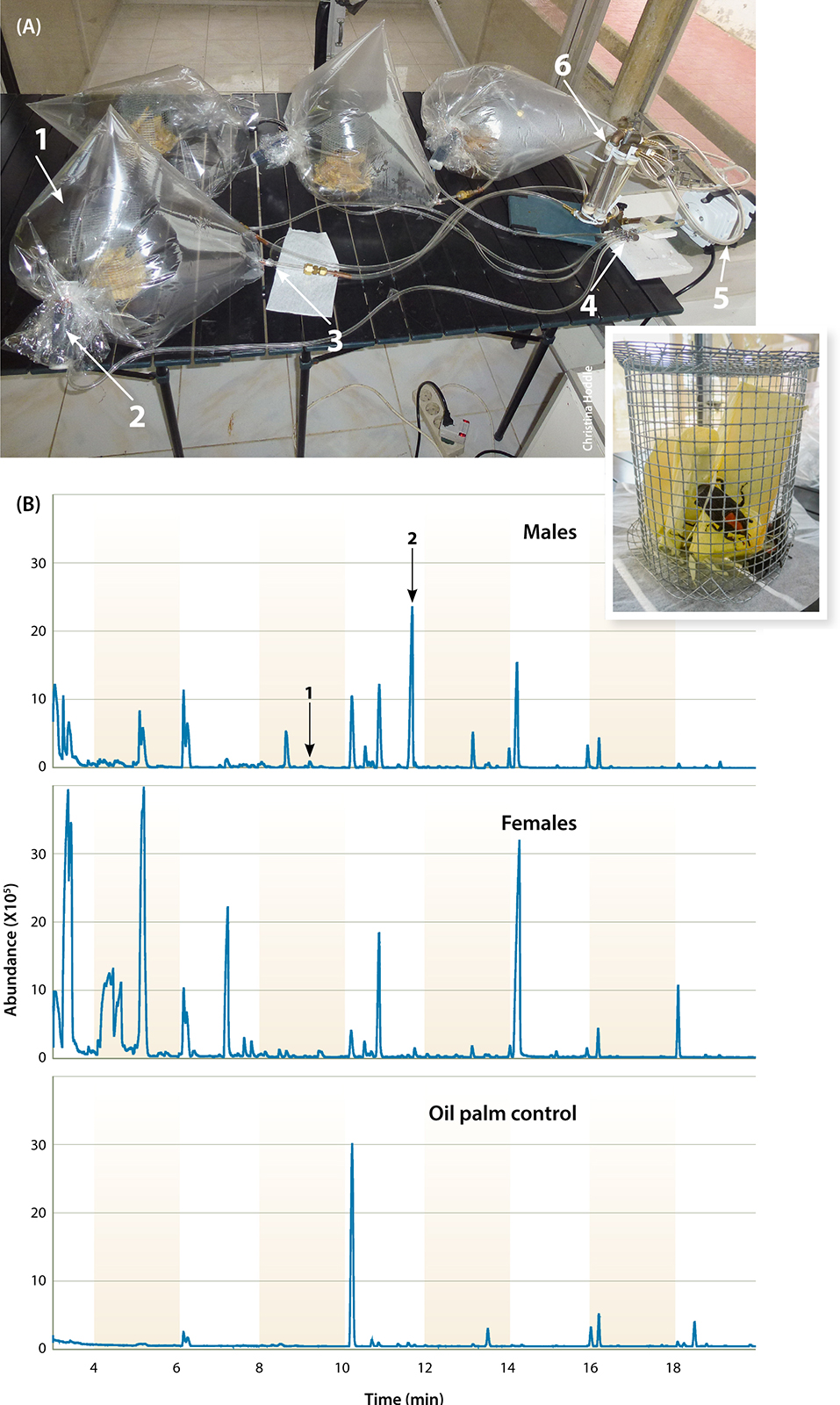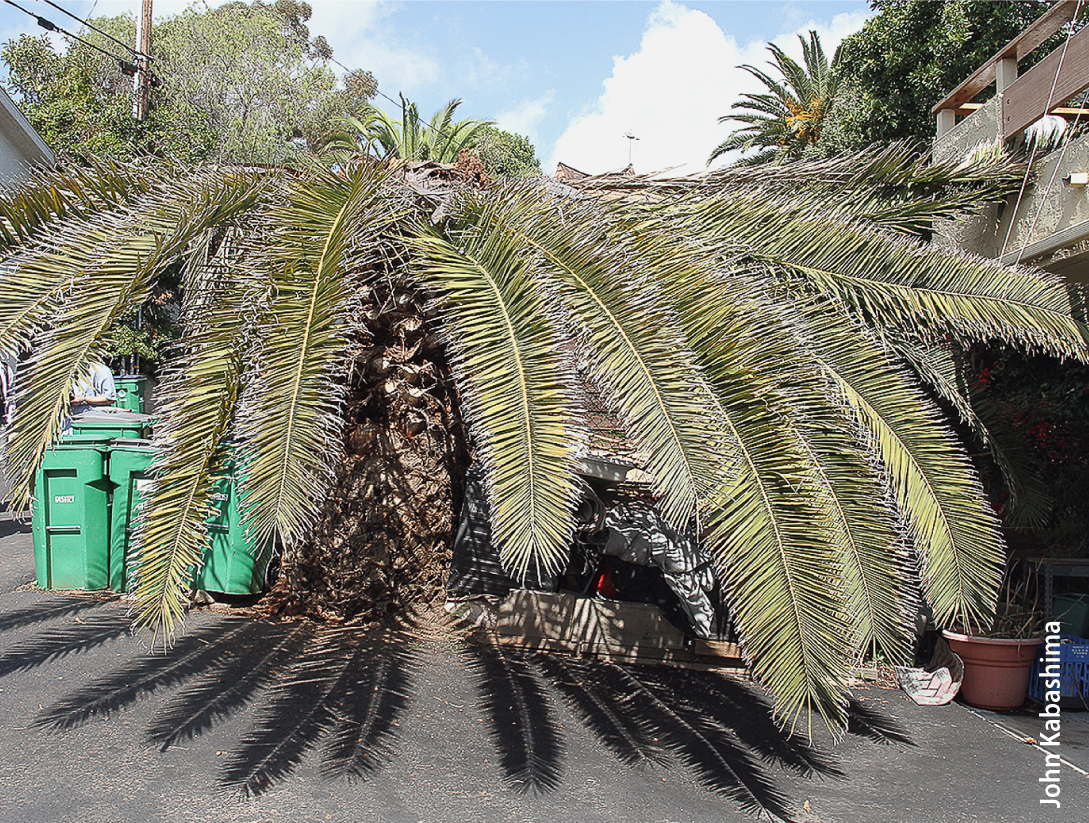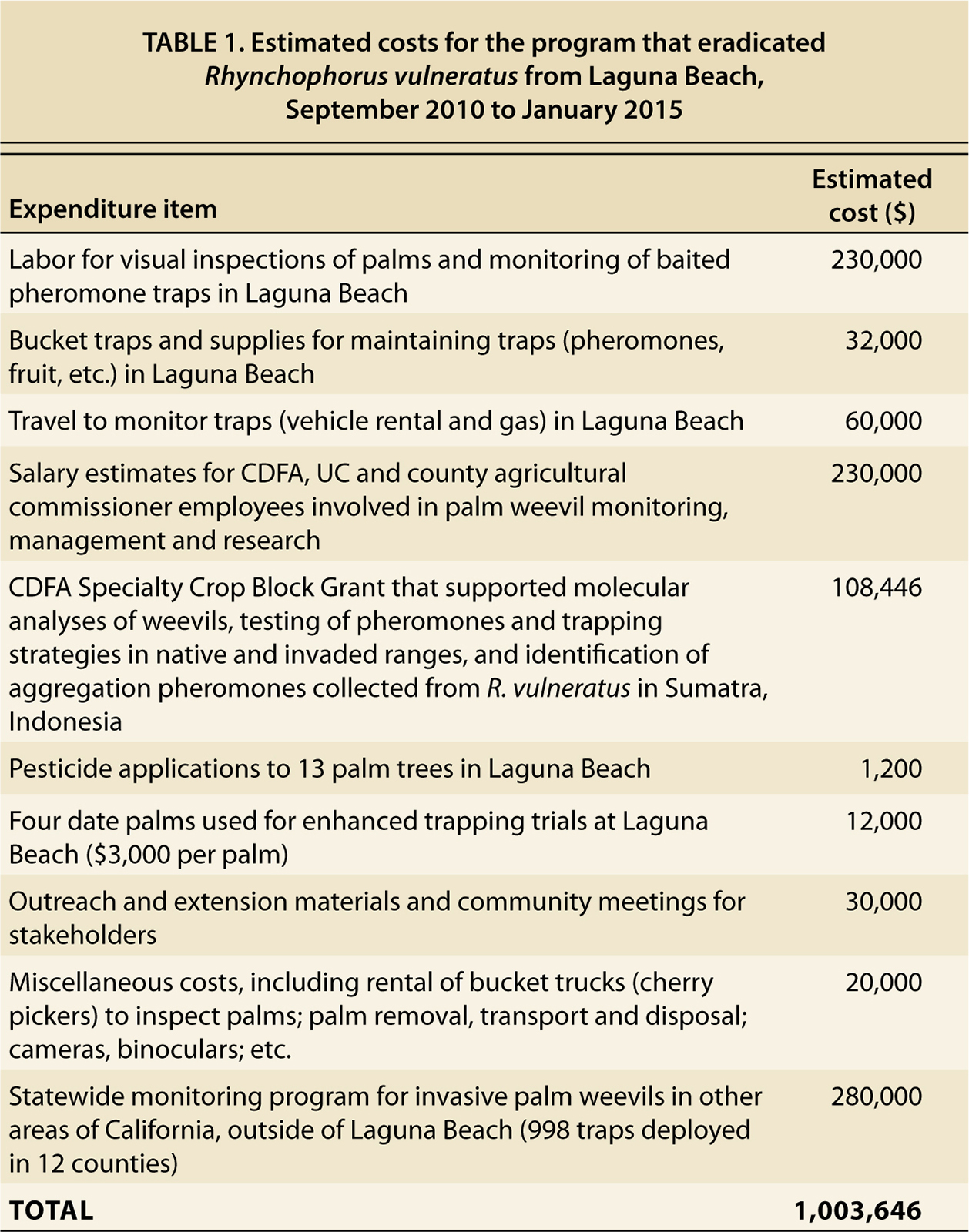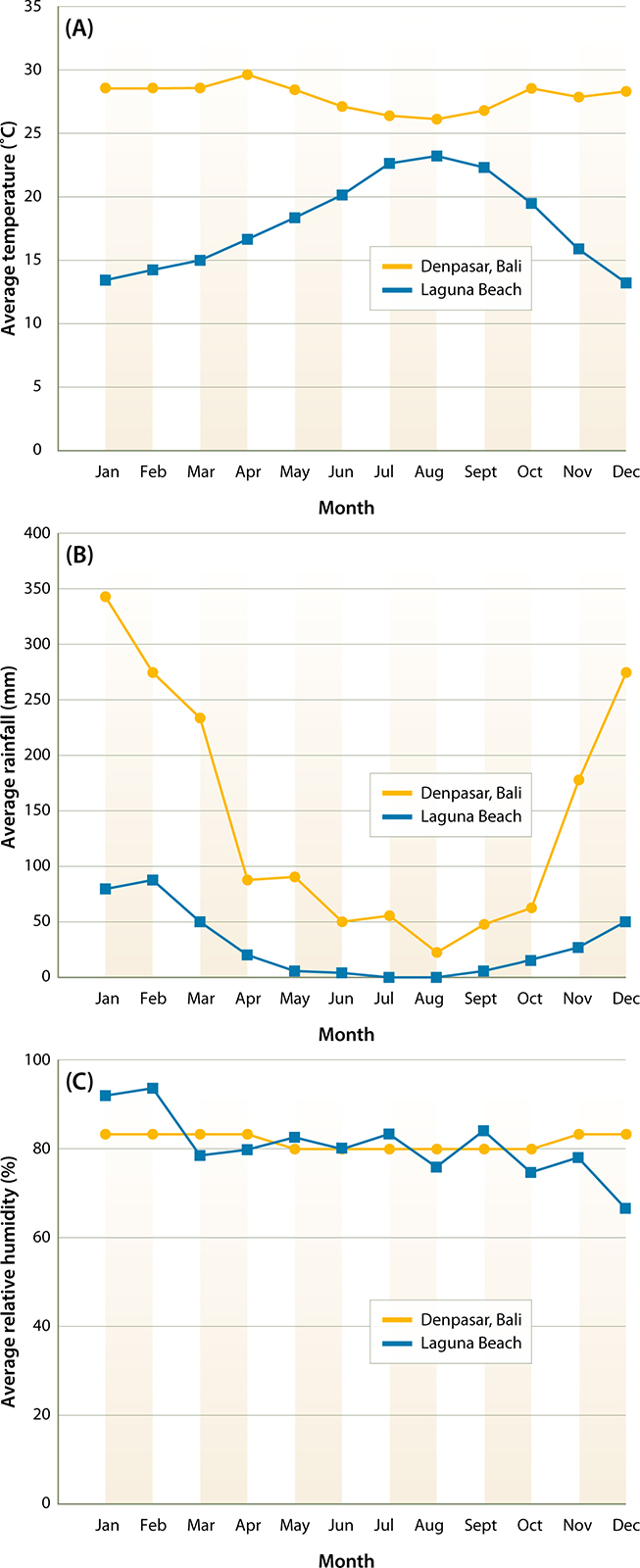All Issues
The palm weevil Rhynchophorus vulneratus is eradicated from Laguna Beach
Publication Information
California Agriculture 71(1):23-29. https://doi.org/10.3733/ca.2016a0012
Published online September 08, 2016
Abstract
In October 2010, Rhynchophorus vulneratus, originally identified as the red palm weevil, R. ferrugineus, was discovered infesting Canary Island date palms in Laguna Beach, California. The red palm weevil has caused extensive mortality of palms in the Mediterranean, the Middle East and North Africa, and its discovery in California caused concern for the state's ornamental palm and date industries and the many palms in Southern California landscapes. A rapid, coordinated effort led to the deployment of traps baited with the weevil's aggregation pheromone, coordinated pesticide applications to privately owned palms and destruction of palms at advanced stages of infestation. Research confirmed the chemical components of the aggregation pheromone, assessed the efficacy of trapping strategies and resolved the taxonomic identity, native range and putative region of origin for the population detected in Laguna Beach. The last confirmed detection of a live R. vulneratus was Jan. 20, 2012. USDA-APHIS declared this weevil eradicated from California on Jan. 20, 2015. The estimated cost of the eradication was $1,003,646.
Full text
On Aug. 3, 2010, a badly damaged Canary Island date palm, Phoenix canariensis Chabaud (Arecales: Arecaceae), was removed by a professional arborist in Laguna Beach, Orange County, California. Examination of the crown by the arborist resulted in the recovery of adult and larval weevils (Coleoptera: Curculionidae). This material was submitted to the Orange County agricultural commissioner's office for identification on Sept. 1, 2010, and the California Department of Food and Agriculture (CDFA) subsequently identified the adult specimens as Rhynchophorus ferrugineus (Olivier) (Coleoptera: Curculionidae), the red palm weevil.
The CDFA's tentative identification was confirmed by the United States Department of Agriculture (USDA) on Sept. 24, 2010. On Oct. 26, 2010, a live adult male weevil was recovered from a second heavily damaged Canary Island date palm in Laguna Beach. The weevil was identified as R. ferrugineus by specialists at the CDFA and USDA (Hoddle 2010a). These two find sites were 0.07 miles (0.12 kilometers) apart.
Adult male Rhynchophorus vulneratus recovered from an infested Canary Island date palm in Laguna Beach.
Laguna Beach is a small (∼ 8.8 square miles [23 square kilometers], 23,250 inhabitants), relatively isolated, wealthy residential area between the Pacific Ocean, to the west, and the dry, relatively undeveloped San Joaquin Hills, to the east. One north-south highway, California State Route 1, and one west-east highway, State Route 133, run through Laguna Beach; the city has no airport, seaport or interstate border crossings. Tourism is a major industry, with ∼ 3 million people visiting the city annually (Turnbull 2004).
Rhynchophorus spp. weevils, especially R. ferrugineus, are notoriously destructive palm pests in native and invaded ranges (Faleiro 2006; Murphy and Briscoe 1999). R. ferrugineus attacks more than 40 palm species in 23 genera. It is a destructive pest of the coconut palm, Cocos nucifera L. (Arecales: Arecaceae), (Giblin-Davis et al. 2013) in its native range, which is the northern and western regions of continental Southeast Asia (e.g., northern Thailand, Vietnam and Cambodia), Sri Lanka and the Philippines (Rugman-Jones et al. 2013). Accidental introduction of R. ferrugineus into regions outside of its native range has occurred via the movement of live palms infested with weevils, and this pest has caused extensive mortality of P. canariensis in the Mediterranean and of date palms (Phoenix dactylifera L.) in the Middle East and North Africa (Faleiro 2006; Faleiro et al. 2012; Giblin-Davis et al. 2013; Murphy and Briscoe 1999).
Discovery of red palm weevil in California was of major concern because the ornamental palm and date industries are estimated, respectively, at $70 million and $34 million annually (CDFA 2013), and palms are ubiquitous in Southern California landscapes. Furthermore, the native California fan palm, Washingtonia filifera (Lindl.) H.Wendl. (Arecales: Arecaceae), restricted to a limited range comprising desert riparian habitats in the western United States, was considered vulnerable because it is a known host for R. ferrugineus (Ju et al. 2011; Longo et al. 2011).
Weevil biology
Palm mortality caused by R. ferrugineus results from internal feeding by larvae (mature larvae can exceed ∼ 2 inches [5 centimeters] in length), which are concealed within the palm during the entire larval life cycle, making detection of early infestations and subsequent control difficult (Giblin-Davis et al. 2013). Internal feeding by two or three generations of weevil larvae over 1 to 2 years can kill infested palms. Palm death results from mortality of apical growing areas (typical for C. nucifera and P. canariensis) or trunk collapse (typical for P. dactylifera) (Faliero 2006; Giblin-Davis et al. 2013; Murphy and Briscoe 1999).
A second Southeast Asian palm weevil species, R. vulneratus (Panzer), was reported to have a more southern distribution in Asia than R. ferrugineus (Wattanapongsiri 1966). A taxonomic revision by Hallett et al. (2004), with specimens collected from west Java, in Indonesia, separated the species primarily on the basis of color differences, with R. vulneratus typically being black with a red stripe on the dorsal surface of the thorax and R. ferrugineus being orange with black markings). Unable to find any significant molecular, morphological or behavioral differences or mating incompatibilities between these two color morphs, Hallett et al. (2004) synonymized R. vulneratus with R. ferrugineus, with R. ferrugineus having naming priority. Therefore, the black palm weevils with a prominent red stripe on the dorsal surface of the thorax (i.e., the R. vulneratus morph) discovered in Laguna Beach were officially identified as R. ferrugineus.
Subsequent work investigating the origin of the palm weevil invasion in Laguna Beach used molecular markers to investigate the identity of the species detected and to ascertain its probable area of origin. DNA-based analyses of weevils collected throughout the presumptive native ranges of R. ferrugineus and R. vulneratus concluded that the weevil species collected in Laguna Beach was R. vulneratus, a species distinct from R. ferrugineus.
Molecular analyses by Rugman-Jones et al. (2013) indicated that R. vulneratus has a native range confined largely to southern Thailand and northern Malaysia on the Malay Peninsula, Singapore, and Indonesia, and that this species has a range of color forms, including that typical of the invasive R. ferrugineus (fig. 1). The results of these molecular studies on species identities and geographic distributions supported earlier work by Wattanapongsiri (1966). It was concluded that Hallett et al. (2004) had been studying different color morphs of R. vulneratus in Java and that R. vulneratus had been incorrectly synonymized with R. ferrugineus (Rugman-Jones et al. 2013). From this point forward, we will refer to the weevil species found at Laguna Beach as R. vulneratus.
Fig. 1. Two color morphs of Rhynchophorus vulneratus recovered from an infested coconut palm in Java, Indonesia. (A) The orange and black morph of R. vulneratus (left) is very similar in appearance to R. ferrugineus. The black morph with the red dorsal stripe (right) is similar to adult R. vulneratus recovered in Laguna Beach. (B) Two color morphs of R. vulneratus copulating.
The only find of R. vulneratus outside of its native range has been in Laguna Beach. The nearest molecular match to the Laguna Beach population was with R. vulneratus collected in Bali, Indonesia (Rugman-Jones et al. 2013). It was hypothesized that the introduction of R. vulneratus into Laguna Beach may have been deliberate, possibly to start a local source of palm weevil larvae and pupae to be used in the preparation of traditional Asian dishes (Hoddle 2015).
Response in Laguna Beach
To delineate the areas in Laguna Beach infested by R. vulneratus, 1-gallon (3.78-liter) bucket traps were loaded with Ferrolure 700 mg (ChemTica Internacional S.A., Costa Rica), which contains the aggregation pheromone 4-methyl-5-nonanol (ferrugineol). Also in the bucket were ethyl acetate (a synergist), fermenting apples as bait and 0.26 gallon (1 liter) of a 50:50 mixture of water and propylene glycol (to drown and preserve weevils).
Trapping commenced Oct. 7, 2010. A total of 150 traps were deployed by CDFA at two different densities within a survey area of 6 square miles (15.6 square kilometers; ∼ 68% of the land area of Laguna Beach). High-density trapping was set at 50 traps per 1 square mile (2.6 square kilometers) around find sites. Outside of this zone, 25 traps were deployed per 1 square mile (2.6 square kilometers). Two additional traps (total number used for monitoring was 152) were deployed at a green waste facility 15 miles (24 kilometers) south of the find sites to monitor for weevils inadvertently moved there in disposed palm material. Traps were attached to palm trunks ∼ 6.6 feet (2 meters) above the ground and inspected daily from Oct. 7, 2010, to Oct. 17, 2010, weekly until March 19, 2011, then biweekly until Jan. 20, 2015, when eradication was declared.
Visual surveys of 13,485 palm trees for weevil damage on 1,963 properties within 6 square kilometers of the initial find sites were conducted by CDFA over the period Sept. 27, 2010, to Oct. 28, 2010. Detection of empty pupal cases or body fragments of dead adult weevils confirmed the presence of this pest in five survey locations. Visual surveys were aided by a large response from residents, local arborists and palm enthusiasts. Reports of symptomatic palms by these groups were investigated by CDFA and Orange County program personnel, and cooperating home owners provided access to private properties. Survey results in Laguna Beach indicated that the area infested with R. vulneratus was ∼ 0.39 square miles (1 square kilometer), which equated to ∼ 4% of the land area of the city of Laguna Beach.
The public response to outreach efforts and subsequent surveys resulted in another pest discovery in Southern California: the first confirmation of the South American palm weevil, R. palmarum (L.) (fig. 2), in California and the neighboring state of Baja California, Mexico (Hoddle 2011a). The high mortality of Canary date palms in Tijuana since at least 2011 has been the source of weevils entering Southern California, and it is likely that R. palmarum will become a problematic pest of ornamental, date and native palms in California, as there are increasing reports of P. canariensis being killed by this pest in San Ysidro in San Diego County. At this time there are no active programs targeting R. palmarum in Southern California.
Fig. 2. Rhynchophorus palmarum adult (A) and larva (B) extracted from a cocoon of palm fibers. Both were collected from an infested Phoenix canariensis in Tijuana, Mexico. This weevil was detected as a result of the public's response to requests for help with the R. vulneratus invasion in Laguna Beach. R. palmarum may have established in San Diego County and potentially poses a serious threat to California's palms.
A technical working group (TWG) was assembled by the USDA to provide expert input into the emerging monitoring and management program for R. vulneratus in Laguna Beach. The TWG included international palm weevil experts, research scientists from UC Riverside, CDFA and USDA, UC Cooperative Extension personnel from San Diego, Orange and Los Angeles counties and county entomologists from the agricultural commissioner's offices in Orange and San Diego counties.
The TWG met at Laguna Beach from Nov. 29 to Dec. 1, 2010 (Hoddle 2010b). The group produced a document with recommendations pertaining to (1) detection and identification of visual symptoms typifying infestations, (2) trapping guidelines, (3) assessment of techniques for early detection of infestations, (4) pesticide treatments, (5) removal and destruction of infested palms and (6) education, outreach and information dissemination to local communities and palm industry professionals (Hoddle 2010c; Hoddle 2011b; Hoddle 2011c).
Despite evidence of damaged palms in Laguna Beach, baited pheromone traps captured only one adult weevil, which was found on Jan. 18, 2012, within 0.21 kilometer of the original find sites. In response to this find, between Jan. 31, 2012, and Feb. 15, 2012, visual surveys of palms for weevil infestations were conducted by CDFA within an area of 0.6 square miles (1.6 square kilometers). A total of 5,564 palm trees were inspected on 782 properties. Two additional properties with palms exhibiting characteristic weevil feeding damage to fronds (leaf notching or holes in the petiole base) were identified. However, weevil presence (pupal cases or adult weevils) was not confirmed.
The low capture rates of R. vulneratus in pheromone traps in areas with apparent or suspected weevil infestations caused concern because it suggested that the pheromone traps might not be attractive to R. vulneratus. If this was the case, then the lack of a sensitive and species-specific monitoring tool could significantly impair the management program targeting R. vulneratus.
Verifying pheromone compounds
Hallet et al. (1993) identified two aggregation pheromone components, 4-methyl-5-nonanone (ferrugineone) and 4-methyl-5-nonanol (ferrugineol), produced by male R. vulneratus (they incorrectly assumed that they were working with R. ferrugineus) collected in Java, Indonesia. To verify the chemical identify of the aggregation pheromone of R. vulneratus as reported by Hallett et al. (1993), male and female weevils were field collected by authors Mark and Christina Hoddle in Sumatra, Indonesia, and used for pheromone collection.
Pheromone collections and controls consisted of four treatments: (1) a sterilized mesh container only, (2) four male weevils on a food source (either sugarcane or oil palm hearts, used separately in case one stimulated pheromone production), (3) four female weevils on a food source and (4) the food source used in 2 and 3 without weevils. All treatments were placed inside heat-sterilized mesh containers, which in turn were enclosed by odorless Terinex oven bags (Terinex Ltd., Bedford, U.K.). The mesh containers held the weevils and food and prevented weevils from chewing holes in the oven bags and escaping.
Treatments 1 and 4 provided control chemical profiles of volatiles from the mesh cage and the food sources, and treatments 2 and 3 provided profiles of volatiles released by male and female weevils. An aquarium pump was used to push purified air into the oven bags over the mesh containers, food and weevils, and as the airstream exited, it was passed through activated charcoal filters, which trapped the volatiles released into the airspace of the bags by the weevils or food items (fig. 3A).
Fig. 3. (A) Rhynchophorus vulneratus pheromone aeration set up in an outdoor screen house in Sumatra, Indonesia. (1) Terinex odorless oven bag enclosing a sterilized wire mesh container holding adult male or female weevils with food (see inset photo). (2) Inlet with 6 to 14 mesh activated charcoal filter to purify ingoing air. (3) Outlet with thermally desorbed 50 to 200 mesh activated charcoal collector to collect volatile compounds emitted by weevils and food items. (4) Manifold to regulate airflow. (5) Aquarium pump to push and pull air through oven bags. (6) Airflow meters. (B) GC–MS chromatograms of volatiles collected from male and female R. vulneratus and the oil palm (food source for weevils) control. Peaks 1 and 2 in the chromatogram for male weevils are 4-methyl-5-nonanone (ferrugineone) and 4-methyl-5-nonanol (ferrugineol), respectively. Schematic prepared by Steve McElfresh.
Aerations were made continuously for 3 to 4 days, and treatments were replicated four times. The trapped volatiles were eluted from the charcoal collectors and analyzed by coupled gas chromatography–mass spectrometry (GC–MS). The insect-produced compounds were tentatively identified by interpretation of their mass spectra, and these identifications were verified by comparing the GC retention times and mass spectra with those of authentic standards obtained from ChemTica.
The analyses showed that two male-specific compounds were produced by R. vulneratus in Sumatra, and they were conclusively identified as the two previously reported aggregation pheromone components obtained for R. vulneratus from Java (Hallett et al. 1993) (fig. 3B). This result raised an important question: What are the aggregation pheromones for R. ferrugineus? The commercially available aggregation pheromone used for R. ferrugineus management was identified from R. vulneratus (Hallett et al. 1993), and to our knowledge, the identity of the aggregation pheromone produced by R. ferrugineus has not yet been determined, although this species is attracted to baited traps containing ferrugineol and ferrugineone derived from R. vulneratus.
Field evaluations of baited traps
The attractiveness of traps loaded with fermenting bait, ethyl acetate and Ferrolure 700 mg was field-tested in the Philippines (R. ferrugineus was the species present at study sites on Luzon Island) and Indonesia (R. vulneratus was the species present on Sumatra). At the time these field studies were conducted, it was assumed that R. ferrugineus was the subject of this work and the only species present in both countries.
In the Philippines, three different treatments were tested for attractiveness to weevils; traps were baited with (1) fermenting dates or pieces of coconut palm heart, ethyl acetate and aggregation pheromone, (2) freshly cut coconut palm logs only and (3) a combination of treatments 1 and 2 (Hoddle and Hoddle 2011). This experiment was repeated in Sumatra and results were similar: baited pheromone traps combined with freshly cut palm logs, treatment 3, were very attractive to R. vulneratus (Hoddle and Hoddle 2015). The volatiles from cut palm logs likely act synergistically with the aggregation pheromones to increase attraction (Hallett et al. 1993).
A combination of traps and cut date palm trunks (date palms were used because coconut palms were not available) was tested in Laguna Beach to determine if it would result in captures of R. vulneratus in areas where activity was observed but no weevils had been caught in traps. Date palm sections were obtained from a commercial palm producer in Coachella Valley, California. Three sites around areas with suspected R. vulneratus activity in Laguna Beach were selected for weevil monitoring with sections of date palm trunks and pheromone traps.
Sections of cut apical parts of palm trunks were stacked beside P. canariensis palms and baited pheromone traps were deployed on top of these stacks. Traps were checked daily from June 21, 2012, to July 17, 2012, for a total of 27 consecutive days. No weevils were found in traps or log stacks. This trial was repeated Oct. 18, 2012, to Nov. 11, 2012, a 27-day period. No weevils were recovered from the second trial (see Hoddle 2012 for more details).
Palm removals, and pesticides
On Nov. 3, 2010, the infested Canary Island date palm that yielded a live male weevil on Oct. 26, 2010, was removed from Laguna Beach and disposed of in compliance with strict destruction protocols (Hoddle 2010d). No live larvae, pupae or adult weevils were found inside the trunk or petioles. This palm was the only one removed as part of the R. vulneratus management program.
A total of 13 palm trees were treated with broad-spectrum contact pesticides applied to foliage and/or systemic pesticides that were applied via trunk or soil injections (Hoddle 2011d; Hoddle 2011e): three P. canariensis (two with confirmed infestations; treated once each), five Howea forsteriana Becc. (suspected infestations based on visual damage assessments; treated three times from August to December 2011), one Chamaerops sp. (suspected; treated once) and four Roystonea sp. (suspected; treated twice from March to April 2012).
One P. canariensis with confirmed R. vulneratus activity was treated with pesticides Jun. 2, 2011 (Hoddle 2011e), then cut down and removed from a private residence in Laguna Beach on Mar. 27, 2013, because it was causing structural damage to an adjacent building (Hoddle 2013). The palm crown and petiole bases on individual fronds were examined for R. vulneratus feeding damage. There was no visual evidence of feeding damage, and no larvae, pupal cases or adults (dead or alive) were found (Hoddle 2013).
Canary Island date palm killed by Rhynchophorus vulneratus in Laguna Beach (note healthy Canary Island date palms in the background).
Declaration of eradication, cost
On Jan. 20, 2015, USDA-APHIS officially declared eradication of R. ferrugineus (i.e., R. vulneratus) from Laguna Beach, 3 years after the last detection of a single live weevil on Jan. 18, 2012 (El-Lissy 2015). The eradication declaration was made in accordance with European and Mediterranean Plant Protection Organization International Standards, which require a period of 3 consecutive years with no pest detections (El-Lissy 2015).
Despite significant data supporting R. vulneratus as the invasive weevil species in Laguna Beach (Rugman-Jones et al. 2013), USDA-APHIS states that it will “continue to refer to this detection as Rhynchophorus ferrugineus until additional information is available” (Molet et al. 2011, revised 2014). This stance is based on the desire of USDA-APHIS for a combined dataset of morphological and DNA information, as well as discrete species diagnoses, to resolve remaining taxonomic uncertainty (Eileen Smith, USDA-APHIS, personal communication, Mar. 31, 2015).
The cost of the eradication of R. vulneratus from Laguna Beach was estimated at $1,003,646. A breakdown of estimated expenditures is provided in table 1.
TABLE 1. Estimated costs for the program that eradicated Rhynchophorus vulneratus from Laguna Beach, September 2010 to January 2015
Success factors
Eradication of an invasive arthropod pest depends on multiple interacting factors. Specifically, small infested areas that can be monitored with highly specific and sensitive tools (e.g., pheromone-baited traps) have higher eradication success probabilities. Furthermore, the smaller the area being treated, the less it costs to eradicate the target (Tobin et al. 2014). These factors likely contributed, in part, to the successful eradication of R. vulneratus from Laguna Beach.
Social, economic, regulatory and political factors also are critical components of eradication programs (Pluess et al. 2012). These may include the authority of regulatory agencies to intervene and take action on private and public lands, procurement of funds to support the project, the commitment and political will of stakeholders affected by the invasion and, very importantly, strong public support for eradication efforts (Tobin et al. 2014). The R. vulneratus eradication effort benefited from strong socioeconomic support.
Organisms need to maintain populations above a critical density, the Allee threshold, if they are to persist. Below this threshold, populations trend toward extinction (Liebhold and Tobin 2008; Suckling et al. 2012). Factors negatively influencing the Allee threshold and increasing extinction risk may include (1) unsuitable climate, (2) suboptimal foods, (3) low genetic variability and (4) control tactics such as the use of pesticides. The interaction of some or all of these factors may have contributed to the successful eradication of R. vulneratus.
First, the climate in Laguna Beach may not have been suitable for vigorous year-round population growth of the weevil. Average monthly temperatures and rainfall are lower in Laguna Beach than in Bali, Indonesia (fig. 4), where weevils with the closest genetic match to specimens collected from Laguna Beach were found (Rugman-Jones et al. 2013). Second, low genetic variability due to the small size of the founding population (Rugman-Jones et al. 2013) may have reduced the fitness of the founding population. Third, the suitability of Phoenix spp. and other palm species as hosts for R. vulneratus is not known, and P. canariensis may be of marginal quality as a host. Collectively, when coupled with targeted pesticide applications to infested palms, these factors may have suppressed population growth and pushed weevil densities below the Allee threshold, resulting in the extinction of this palm pest at Laguna Beach.











